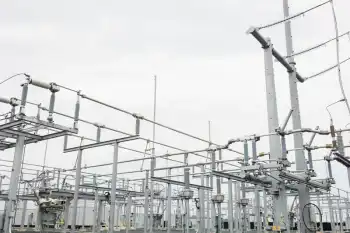Venture capital shifts to energy efficiencies
By New York Times
Protective Relay Training - Basic
Our customized live online or in‑person group training can be delivered to your staff at your location.

- Live Online
- 12 hours Instructor-led
- Group Training Available
Investors in clean technology were just not excited about Silver Spring, because it makes hardware and software that utilities use to connect electric meters in a digital grid. They were more interested in companies that envisioned making energy from the sunÂ’s rays, algae or tropical plants.
“People laughed at us,” said Adam Grosser, a partner at Foundation Capital.
Last summer, the thinking in Silicon Valley began to shift. Five top venture firms vied to invest in Silver Spring. The company chose Kleiner Perkins Caufield & Byers, perhaps the most well-known green technology investor, and two of its partners, John Doerr and Al Gore, joined Silver SpringÂ’s advisory board.
Venture capital is starting to move away from its infatuation with alternative energy and returning to one of its traditional strengths: applying information technology to improve the efficiency of energy consumption.
Many investors say developing new forms of energy can consume hundreds of millions of dollars over many years before showing any return. Mr. Grosser’s firm, however, is looking for technologies that reduce demand for energy. “We need to move markets with small amounts of money,” he said.
About half of the dollars invested in clean technology last year went to alternative energy companies. In the first quarter of 2009, though, only one-third of venture dollars invested in clean tech went to these companies, the National Venture Capital Association said.
Not all investors in clean technology think alternative energy companies must be capital-intensive. Khosla Ventures, one of the most prominent venture firms, has invested in companies that make fuel from corn, sugar, plants, wind and the sun.
“I think that’s a false generalization for people who take a very superficial view of clean technology,” said Vinod Khosla, the firm’s founder. “It’s not that hard to find ways around capital intensity. We are very active in doing that, and it involves technology or business strategy.”
Mark Heesen, president of the National Venture Capital Association, said the eBay or the Google of the clean tech industry is not going to come from energy-efficiency companies but from those that create new forms of fuel. “Does it cost more money to do that? Absolutely,” Mr. Heesen said. “But when it comes to game-changing technologies, you’re not going to get it with doubles and triples.”
Not all firms want to play that game. Sequoia Capital, which made its name investing in Google and Yahoo, avoided green technology because the start-ups did not fit the capital-efficient model Sequoia was looking for, said Michael L. Goguen, a partner at the firm who invests in clean tech.
After more investigation, though, Sequoia discovered that there were thousands of capital-efficient clean tech companies. They just “weren’t the companies that a lot of people were talking about, putting steel in the ground and building plants for fuels,” Mr. Goguen said.
Sequoia invested in SynapSense, for example, which makes sensors that help data centers use less energy. MDV, an early investor in clean tech, backed Nanosolar, a thin-film solar cell company that has already raised $500 million. Now, MDV is focusing more on saving money. It invested in Gordon Murray Design, a company that will design eco-friendly cars but not build them.
Foundation Capital, which hires former entrepreneurs, not bankers, as investing partners, early on set a firm rule for green tech: it would not invest in any start-ups that needed hundreds of millions of dollars in capital, government subsidies or high oil prices.
The partners started exploring clean technology in 2002 and estimate that they look at a thousand start-ups each year. They found nine and are now investing about a quarter of their $750 million fund in clean tech companies.
Warren Weiss, one of Foundation CapitalÂ’s clean tech partners, heard about Silver Spring, which was started in Milwaukee. It equips electric meters with networking cards so utilities can see power failures before customers call. In addition, customers can see which of their appliances use the most electricity and at which times of day they need to conserve.
In 2003, Mr. Weiss and Mr. Grosser visited a dingy, crowded warehouse and ate deep-fried Twinkies with whipped cream with the founders.
Foundation Capital invested $8 million, moved the company to a technology office park in Redwood City, Calif., hired a new chief executive, Scott Lang, and began pitching investors.
After Silver Spring ran out of cash in 2005, Foundation Capital kept it alive for 15 months with monthly loan checks. In 2007, it found a new investor, Duquesne Capital Management. Around that time, Silver Spring landed its first big contract, with Florida Power and Light. Other utilities called, including Pacific Gas & Electric and Pepco Holdings, based in Washington.
Today, backed by Kleiner Perkins and Google’s venture fund, Silver Spring is heralded as a promising green tech start-up with the potential to go public. “I think they have recognized our strategy is viable,” said Mr. Grosser about Kleiner Perkins.
Foundation Capital also invested in SunRun, which sells solar power to homeowners. It does not make solar panels, though. Instead, it offers solar power for a monthly fee so homeowners do not have to pay the installation and maintenance costs of rooftop panels.
Foundation CapitalÂ’s most successful investment so far is EnerNOC. It monitors energy in office buildings, grocery stores and hospitals and alerts operators to move power to places that need it most from those that need it least.
On a hot summer day, for example, EnerNOC will automatically shut off one-third of an office buildingÂ’s lights, turn the air-conditioning down three degrees and stop the fountain in the lobby so the energy can be used elsewhere.
Paul Holland, another Foundation Capital partner, met EnerNOC’s co-founders in 2002 at Dartmouth, where he was talking to business students. EnerNOC’s idea — to regulate energy supply and demand — stuck with him.
Two years later, the founders called him, and Foundation Capital invested $21 million.
EnerNOC went public in May 2007, five years after its first round of venture capital, and raised $98 million in its public offering of stock. Its revenue was $106 million last year, and that is expected to grow 55 percent this year, said Timothy G. Healy, its chief executive.
“There are a lot of people who went down that path of solar and fuels and wish they didn’t,” Mr. Grosser said. “From where we sit, we are very grateful we didn’t put a pile of money down.”











